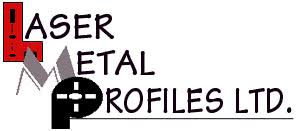
We collect basic website visitor information on this website and store it in cookies. We also utilize Google Analytics to track page view information to assist us in improving our website.
Laser cutting, the foundational aspect of our business processes at Laser Metal Profiles, is a thermal operation that uses a laser beam to pierce and slit raw material in an isolated area. Essentially, the laser powered beam is concentrated on a single point that has a diameter ranging from 0.08 mm – 1 mm depending on the thickness and type of material. At LMP, as seen on our products page, we exclusively cut steel. With this, the laser cutting process can be broken down into an eight step process.
1. Optics: Focusing the beam
The laser cutting equipment that operators use at LMP include two important components: the lens and mirror optics. Without these, the machine will cut inaccurately and inefficiently. The focus is achieved through the use of multi-lens optics that measure the focal length and the diameter of the space in-between. Moreover, the mirrors act as a guide for the lens so that it can verify the horizontal coordinates on the grid are correctly located to ensure the cut is done correctly according to the documents provided by the customer.
2. The Laser Beam
The mechanism that is responsible for cutting through the material is known as the laser beam. This is exactly how it sounds; a beam is directed to a localized area that heats up the material to the point where it either evaporates or melts. Once this happens the process of cutting has occurred. Interestingly, the process includes no contact which ensures that the parts that are being cut incur no damage. Considering the beam is guided based upon a program created by our CAD department, LMP ensures accuracy and proficiency.
3. Cutting Gas
At LMP, our machines use oxygen, nitrogen, and compressed air as the cutting gas. Oxygen or argon gasses are also used for laser cutting machines but the latest technology of these machines use oxygen and nitrogen as the preferred gas types. Another benefit that these gasses have is that they have virtually no reaction to the melted metal which in turn, prevents residue on the customers parts or in the environment. Additionally, the reduction of burrs are often observed in aluminum, stainless steel or mild steel material when being cut with the use of nitrogen gas.
4. Drag lines
When laser cutting, there are “drag lines” on the surface of the part. It is known to be a good cut when the lines are thinly and consistently present along the parallel line of the part. Essentially, this pattern is parallel to the cutting head and beam of the laser. An example is provided in the photo below. This can be perfected by ensuring the machine set-up prior to cutting.
5. Melt
Whenever raw material is cut, as mentioned above, the beam is strong enough to melt the material at the localized point. In other words, the beam emits a certain amount of energy where at its threshold,it will burn right through and oxidize the steel being cut.
6. The Cutting Point
This part of the process is the most critical for ensuring the parts are cut cleanly and without a great amount of residue. On the laser cutting table, there are coordinates for the cutting head to calibrate to. This streamlines the operations as it allows for the cutting head to get the most precise cut and location.
7. The Nozzle
The brass nozzle is at the bottom of the cutting head, the closest point to the material on the machine's table. As such, this is an important part of the cutting process because this is where the gas used for cutting and the beam of the laser intersect. Moreover, there are different types and sizes of nozzles. In short, this can include specific shapes that are optimal for cutting speed, edge quality or gas optimization.
8. The Cutting Direction
When the cutting head is moved around the X and Y axis during the programmed cutting schedule, a kerf is formed. An important caveat with the counting direction is the laser light that guides the cutting head. If the light is parallel to the cutting direction, a smooth edge will result. If the light is perpendicular to the cutting direction, it will create a burr on the material. The cutting quality is contingent on this aspect. Evidently, the cutting direction must be properly set-up to ensure the most accurate cut possible.
As described throughout this article, the intricacies of each process in the laser cutting process is equally important so that the machine can function properly. When they all come together, the laser cutting quality and efficiency reaches optimal levels
Thank you for reading our blog post! Don't forget to leave a Google Review and follow us on our social media accounts!
Instagram: @LaserMetalProfiles
LinkedIn: Laser Metal Profiles Limited
============================================================
References
Laser cutting as a contact-free slitting process. (2022). TRUMPF. Retrieved May, 2022, from https://www.trumpf.com/en_CA/solutions/applications/laser-cutting/
